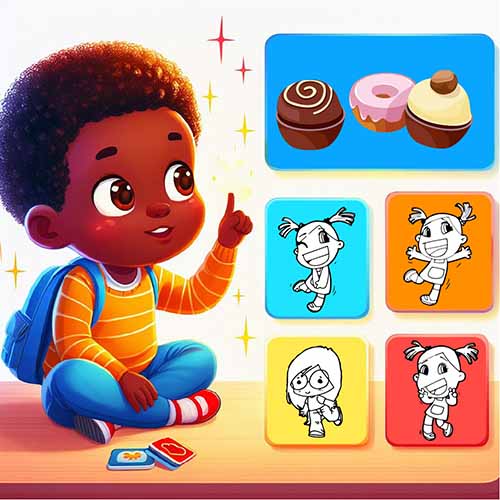Are There Enough? - Pre-K and Kindergarten Lesson Plan
-

Child checking if the snacks are enough for four children -
Hello, are your kids ready for an enriching lesson with fun activities on comparing numbers: Are there enough? If yes, join them to enjoy this lively lesson with emojis, fun videos, discussions, and problem-solving skills.
In addition to videos, your Pre-K and K students will participate in hands-on activities and develop their critical thinking skills. One such activity is determining if a given set of objects can be shared equally among a specific number of individuals.
How to teach “Are there enough” comparing lesson effectively with MathSkills4Kids’ videos
-
Objectives
- To help students learn how to determine if a given set of objects has enough or not enough items for a specific purpose, such as sharing among a certain number of individuals.
- To provide opportunities for them to work with larger sets of objects and sets of different sizes.
- To help students determine how many more or less one set has than the other.
- To enhance kids’ observation and counting skills.
- To develop and practice one-to-one correspondence
-
Previous knowledge
Ensure that your students can already:
- Count up to 20
- Using symbols and language to compare numbers up to 10.
- Have an understanding of the numbers up to 20 and the value they will be working with
- Represent quantities with fingers.
Materials
- Counters (e.g., small toys, buttons, or blocks)
- Chart paper or whiteboard
- Marker
- Video on ‘Are there enough
READ THE PROCEDURE
-
Introduce 'are there enough' lesson
- Gather the students and display an emoji like 🚀 to represent embarking on a learning adventure.
- Discuss the concept of sharing and explain that today, they will learn to see if there are enough objects for everyone.
- Use emojis like 🙌 and 🤗 to show enthusiasm and excitement about the upcoming lesson.
-
Warm-up
- Start by holding up a small number of counters (e.g., two or three) and ask the students if there are enough counters for everyone.
- Encourage the students to share their opinions and reasoning.
- Use emojis like 🤔 and 🗣️ to stimulate thinking and promote discussions.
-
Introducing the concept of are they enough
- Show the students the video to introduce the concept of having enough or not enough objects.
- Pause the video at key points to discuss with the students and ask questions.
- Use emojis like 💡 and 📢 to indicate insight and active participation moments.
-
Games and activities
- Divide the class into small groups.
- Provide each group with a set of counters.
- Assign a specific number of "persons" or "animals" for each group. For instance, four counters for three individuals to share.
- In their groups, have the students determine if there are enough counters for each "person" or "animal."
- Please encourage them to count and distribute the counters accordingly.
- Walk around the classroom, offering support and guidance as needed.
- Use emojis like 🙌 and 🖐️ to celebrate successful sharing moments.
-
Group Sharing
- Bring the groups back together and have them share their experiences, determining if there were enough counters.
- Discuss what challenges they encountered and strategies they used.
- Use emojis like 💡 and 📚 to show the importance of learning from each other.
-
Conclusion
- Recap the concept of determining if there are enough objects for a specific purpose.
- Ask students to share real-life scenarios where they must check for enough items for everyone.
- Use emojis like 🌟 and 🎉 to emphasize their achievements in understanding the concept.
Assessment
- Observe students' engagement during the activity and group discussions.
- Assess their ability to determine if there are enough or not enough objects for sharing purposes.
- Provide individualized feedback using emojis like 👏 and 🌟 to recognize their progress.
🌈 Enjoy this exciting journey of discovering if there are enough or not enough things to share with each other. 🌟 For more math videos and resources, visit our website at https://mathskills4kids.com/.
Please CLICK THE SHARE BUTTON to allow others to benefit from this content!
